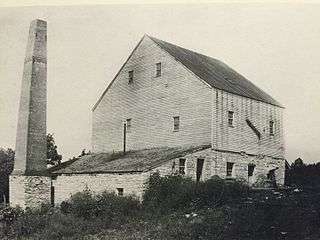Monroe City Mill
The Monroe City Mill was a grist mill located in Monroe City, Illinois, an unincorporated community in the historic Bluff Precinct of Monroe County, Illinois, United States.[1] The Mill was built in 1800 and ceased operation in 1899.[2][3] The stone foundation, including the water wheel arch remain today on the original site.

The Mill was located on the north bank of the Monroe City Creek, about one quarter mile below its source at a karst spring.[4] The creek provided water to power the mill. The valley created by erosion from the creek is generally referred to as "the Monroe City Hollow."
Over the years, the Mill has been referred to by a number of names, primarily reflecting ownership: Kinney's Mill from 1800 until about 1823; James' Mill from about 1823 until 1850; Ziebold's Mill from 1850 until 1856; and Monroe City Mill since 1856 when the Town of Monroe City was platted. In 1798, Josiah Ryan built a mill in the Monroe City Hollow about 2 miles west of the Monroe City Mill site, also on the banks of the Monroe City Creek.
Kinney's Mill

In 1800, Andrew Kinney built the original Mill at the current site.[3] According to the Combined History (1883), "Where Monroe City now stands Andrew Kinney built a water mill, and this vicinity, at an early time, became one of the important business points of the county. From this mill flour was shipped to St. Louis and to New Orleans before the war of 1812."
Kinney also built a dam on the creek about 200 yards upstream. The dam was about 15' tall and collected water which was channeled to the mill through a wooden trough. Remains of the dam can still be seen.
John Great, an emigrant from Maryland was the stonemason.
One grindstone is on display at the Rosalie Baum home across the creek from the mill.
In 1814, Kinney installed a cotton gin at the Mill. Below is an advertisement that appeared in the Illinois Herald newspaper, announcing the cotton milling service.[5]

James' Mill

General Thomas James purchased the Mill sometime between 1823 and 1827, after he returned from his New Mexico expedition.[3] The Mill burned and James re-built it in 1827.
Ziebold Mill


In 1850, Gottlieb Ziebold purchased the Mill. In 1851, he converted the Mill to steam power. The dam may have been abandoned at this time, in favor of a direct, iron pipe from the spring to the Mill. (There is no authoritative record as to when this change was made.) In 1882, Charles Duryea was hired to convert the rock grindstones to metal roller technology, along with a general modernization of the milling equipment.[3]
The steam boiler required continual monitoring. One day in 1899, the operator tarried too long at one of the local taverns. While he was away, the steam pressure built too high and exploded. The resulting fire destroyed the mill and was never rebuilt.[3]
Ryan's Mill
The first Mill in Monroe City was built by Josiah Ryan in 1798. It was apparently located further west on the creek, near Golden's Blockhouse.[3]
References
- "Monroe City, Illinois". Geographic Names Information System. United States Geological Survey.
- 'Arrowheads To Aerojets,' Helen Klein, Myron Roever Associates Publisher, 1967, Pages 521-525
- Combined History of Randolph, Monroe and Perry Counties, Illinois. J. L. McDonough & Co., Philadelphia. 1883.
- W.T. Frankie; D.A. Grimley; R.J. Jacobson; R.D. Norby; S.V. Panno & M.A. Phillips (1997). Guide to the Geology of the Columbia and Waterloo Area, Monroe County, Illinois. Illinois State Geological Survey.
- The Illinois Herald, December 4, 1814